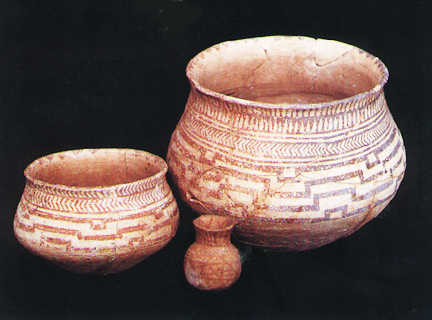
Polychrome painted bowls, Samarra, Earthenware
6300-6000 BCE
ART 198 - HISTORY OF WORLD CERAMICS
| Early vessels were hand built from coils, but potters soon learned to decorate their pots with simple patterns painted in clay slips colored with earth minerals such as iron oxide. These bowls, from Samarra, and early culture in the Tigris/Euphrates Valley show patterns reminiscent of basketry designs and may reflect the influence of that craft on pottery making. Coil building in clay is very similar to the coiling technique used in basketry, and some believe that this forming technique was borrowed from the earlier craft of basket making. Baskets were preferable to hunter/gatherers due to their light weight and, of course, would not break like pottery. However the clay vessel made a much better container for food and water storage, and was of greater usefulness to the agricultural communities of the Fertile Crescent. What is a constant is that vessel making and agriculture go hand in hand, so that wherever there farming, there is pottery. These pots have marks on their undersides which may be those of the makers. Pots from Samarra have been found throughout Mesopotamia indicating extensive trade among settlements. The Tigris and Euphrates rivers, like the Nile, were prone to periodic flooding which would have provided rich farmlands as well as plentiful supplies of smooth, plastic clays washed down from the mountains far away. | Polychrome painted bowls, Samarra, Earthenware 6300-6000 BCE |
|
|